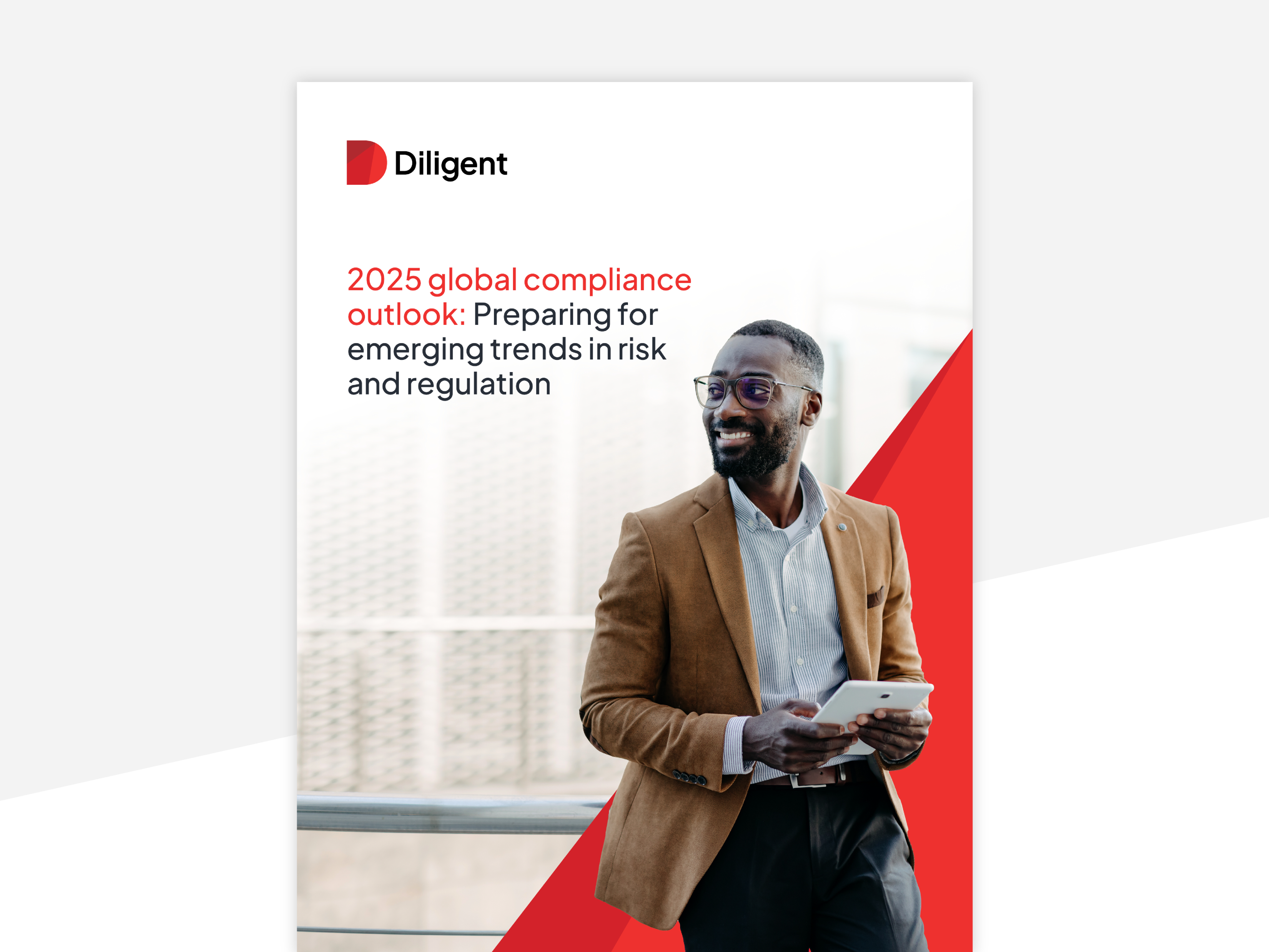Navigating compliance in 2025: Key insights and strategies from industry thought leaders

— Dr. Hemma Lomax, Founder, CEO and Chief Compliance Coach, Compaas 360.
Imagine a world where every decision is scrutinised under a microscope, and even the smallest misstep can result in significant financial penalties or reputational damage. This is how it can feel for compliance professionals today, as managing compliance risks has become more challenging than ever. Organisations are struggling with increasing regulations, complex global operations, and rapidly advancing technology.
How do you navigate this complex web of regulations and risks? How do you ensure your organisation stays compliant while fostering a culture of transparency and engagement? To help answer these questions, Diligent recently hosted the 2025 Global Compliance Outlook webinar, sharing highlights from our guide ‘2025 global compliance outlook: Preparing for emerging trends in risk and regulation.’
Featuring insights from Dr. Hemma Lomax, Founder, CEO and Chief Compliance Coach at Compaas 360and Scott Bridgen, General Manager of the Risk and Audit Business Unit at Diligent, the session covered critical topics such as compliance risk management, mitigation strategies, and emerging regulatory themes. Below are some of the key takeaways from the discussion. For a deeper dive into the topics, you can watch the full webinar here.
Transforming compliance from a hindrance to a supportive guide
Compliance and risk management are often perceived as barriers to progress rather than tools for successful long-term growth. However, a shift in perspective is essential. Dr. Lomax emphasised, "Compliance is due its own revolution. We can cut through the noise. We can prioritise and we can make a plan." The role of compliance professionals should be to guide employees and third parties to their destinations responsibly, as a service, rather than being seen as obstacles.
— Scott Bridgen, General Manager, Risk and Audit, Diligent
By breaking down these barriers and translating compliance into the language of the organisation, employees will be more engaged, making compliance more effective and less burdensome.
Actionable tip: Shift your compliance approach from a top-down directive to a supportive guide. Having the right, up-to-date policies and procedures is table stakes. Focus on transparency and clear communication to foster better collaboration and understanding among employees.
Leveraging AI and ensuring data integrity
AI and data integrity are pivotal in managing compliance risks. Dr. Lomax highlighted, "AI will help us gather, consolidate, and analyse information to make informed decisions. But what if the data it analyses is rubbish in, rubbish out?" Ensuring the quality and integrity of data is crucial for AI to be effective.
Bridgen discussed the potential and challenges of AI in compliance: "It is data agnostic from that perspective. It can pull from many intangible size places and different types of areas." However, he warned about the risks of AI hallucinations and the creation of an "intangible set of issues" when AI models are daisy-chained together.
Actionable tip: Use AI to analyse existing data to identify and address issues. Ensure the data being used is of high quality and integrity to maximise the benefits of AI in compliance risk management.
Adopting a strategic, prioritised approach to regulatory challenges
The regulatory landscape is becoming increasingly complex, and a strategic, prioritised approach is essential. Dr. Lomax noted, "There's a lot of things. ESG is taking up a lot of time when it comes to the global companies and the scope assessments and materiality assessments." Prioritising and making strategic plans, even if they span multiple years, is crucial.
Bridgen provided insights into regional differences in regulatory approaches: "Traditionally, again, I think North America takes a compliance-based approach. Europe takes a risk-based approach. That has shifted actually a lot in the last 2 to 3 years." He emphasised the importance of working smarter and avoiding duplication in compliance efforts with integrated risk and compliance solutions.
Actionable tip: Develop a strategic plan that balances objectives with key regulations as part of your risk management program. Leverage industry benchmarking and peer collaboration to navigate the complex regulatory landscape more effectively.
2025 Global Compliance Outlook
Navigate 2025's compliance complexities and protect your company's integrity. Discover expert insights and strategies to stay ahead of emerging trends and regulations.
Download hereEmphasising the human element in compliance
The human element is crucial in compliance, as it ensures that ethical standards and regulations are not just followed but ingrained in the organisation's culture. Dr. Lomax emphasised this point:
— Dr. Hemma Lomax, Founder, CEO and Chief Compliance Coach, Compaas 360
Compliance risks can often surprise organisations, manifesting as unexpected legal issues in diverse business areas. The solution is to ensure compliance is a part of everyday activities, rather than an afterthought, to anticipate and mitigate these risks effectively.
Actionable tip: Embed compliance into daily operations and focus on the human element across different teams and offices with engaging content that is relevant to different environments. Foster a culture of transparency and engagement to make compliance a part of the organisational fabric.
Addressing third-party risks and enhancing due diligence
Sanctions and third-party risk remain significant, with the need for enhanced due diligence and a focus on the entire ecosystem. Dr. Lomax emphasised, "Our reputations as corporations are no longer just about what we do within our own four walls. It definitely depends on the entire ecosystem."
Bridgen added, "The fatigue that sets in with assessments is just horrendous. It's going to get worse before it gets better." He highlighted the importance of focusing on the right risks in order to vet vendors and mitigate third-party risks effectively.
Actionable tip: Enhance due diligence processes and focus on the entire ecosystem. Prioritise key vendors and risks to mitigate third-party risks effectively.
Moving forward with confidence
The future of compliance is about more than just meeting regulations—it's about fostering a culture of integrity, resilience, and proactive risk management. By embracing a human-centric approach, leveraging AI for smarter decision-making, and ensuring data integrity, organisations can turn compliance from a challenge into a strategic advantage.
Discover how Diligent can empower your organisation to stay ahead of compliance challenges and seize new opportunities here.
Keep exploring

2025 global compliance outlook
Download our 2025 global compliance outlook to confidently navigate complex regulations, enhance risk management and secure your company's future.

Governing AI and AI in governance: Balancing risks and rewards
A panel discussion in London focused on the balance between using AI to clarify GRC and effectively managing its risks.

Corporate Governance
Corporate governance is a system of accountability for the boardroom to fight corruption and ensure that businesses follow a code of ethical conduct.
